South Asian cuisine
regional cuisine
While South Asia is a vast subcontinent with diverse climate and culture, some culinary traditions can be found across the region.
| Cuisines of Asia and Oceania Australian • Burmese • Cambodian • Chinese • Filipino • Indonesian • Japanese • Korean • Malaysian, Singaporean and Bruneian • Middle Eastern • South Asian • Thai • Vietnamese |
With the Indian, Pakistani, Bangladeshi, Nepali and Sri Lankan diasporas, not least within the former British Empire, the cuisines of South Asia have spread around the world.
Understand
.jpg.webp)
With 1.75 billion inhabitants, a land area larger than the European Union, a countless number of languages and dialects, and millennia of written history, South Asia is difficult to conceptualize. However, the region has had some unifying cultural factors. While the Dharmic religions (mainly Hinduism, Sikhism, Buddhism and Jainism) are rooted in the region, Islam, Christianity and a small Jewish community also have long histories, along with a Zoroastrian community (called the Parsees or Iranis depending on when they migrated from Persia/Iran to India). All these religions have contributed to the kaleidoscope of flavours now generically called "Indian cuisine". For example, Hindus avoid beef but tend to make great use of dairy products such as yogurt and cheese (paneer); among Muslims in Northern India and adjoining areas of Pakistan, goat curries and tandoori meat dishes are popular; Jews avoided mixing meat and dairy due to kashrut rules and developed dishes using eggs with meat instead; and the Parsees in Gujarat contributed the rich dumpakht dishes, which are made by sealing the top of a cooking vessel with bread.
Throughout periods of its history, the subcontinent often had a dominant government, such as the Maurya Empire, Gupta Empire, Mughal Empire, British Raj, and today's India. All the various empires, including the British, have also contributed to Indian cuisine as we know it today. Neighboring lands have also made their influence felt. For example, there is an entire repertoire of Indian Chinese dishes that constitutes the cuisine colonial-era Chinese immigrants brought with them and adapted to Indian tastes.
South Asian diaspora communities often have dishes that are locally adapted or invented, and thus cannot be found within the subcontinent. When travelling to such areas, it is often worth trying out some of these dishes; you may be pleasantly surprised by what you get. Famous examples of such dishes include chicken tikka masala from the United Kingdom, roti prata / roti canai from Singapore and Malaysia, and bunny chow from South Africa.
Food in South Asia is traditionally eaten by hand, though a fork and spoon may be used in more upmarket establishments. If eating by hand, it is important to use only your right hand to handle food, as the left hand is traditionally reserved for dirty things like cleaning yourself after using the toilet.
Countries and regions
- In Pakistan and northern India, wheat is the predominant crop, and bread (generally flatbread), existing in many varieties including naan, roti, paratha, kulcha, puri and pappadam, is a common staple food. Breads may be plain or filled with various forms of usually savoury filling. Breads in the western regions of the Subcontinent have similarities with those in Iran, Central Asia and the Middle East.
- The cuisines of southern India, eastern India and Bangladesh are based on rice and legumes, with occasional seafood.
- Udupi is especially famous for its vegetarian cuisine.
Ingredients
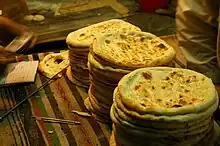
Rice
Rice is the basic staple food in southern and eastern regions of South Asia. Rice flour is used to make the savoury pancakes called dosas and utthapams that are so characteristic of South Indian food. A number of varieties are eaten. Long-grained and aromatic basmati rice is typically used in North Indian and Pakistani curry dishes. Red rice, which has a nutty flavour and chewy texture, is the only type that can be grown at very high altitudes and as such, is the main variety eaten in Himalayan Bhutan and parts of Nepal.
Bread
Flatbreads are the staple food in the northwestern parts of South Asia. The variety in flatbreads is huge, varying by the flour used and method of cooking. Roti is the generic term for bread in many South Asian and Southeast Asian languages, but in much of India and Pakistan, it is also colloquially used as a synonym for chapati.
- Naan: A thick and chewy, leavened flatbread that is baked in an oven or tandoor (traditional clay oven), mostly associated with the cuisines of North India and Pakistan. The most common types are plain naan, garlic naan, butter naan, cheese naan (stuffed with either paneer or nowadays melting cheeses like cheddar and mozzarella) and Peshawari naan, which contains nuts and raisins.
- Chapati: A thin and coarse, unleavened flatbread cooked atop a tava (shallow pan). Chapatis are typically made from whole wheat flour unlike naans, giving them an earthier taste and are considered to be the healthier option.
- Paratha: A layered flatbrad from North India and Pakistan, made by kneading and folding the dough multiple times, using ghee to separate the layers of dough, then shallow frying it in ghee on a tava. Paratha can also be stuffed, in which case it is usually not layered.
- Parotta is the South Indian counterpart of paratha, though with a slightly different preparation method. The dough used to make parotta is spread thinly by flipping it onto a smooth and flat surface several times, before folding the dough onto itself, then frying it in ghee on a tava. A variant of the parotta, known as roti prata in Singapore, and roti canai in Malaysia, is a popular breakfast dish made by the Tamil Muslim diaspora in those countries.
Roti can also be made from other grains. Notably, in the Punjab region, makki di roti made from whole corn flour is a local delicacy and is paired with either sarson da saag (mustard greens curry) or shalgam (turnips).
Other flatbreads include deep-fried pudis and bhatooras, poodas (savoury chickpea pancakes) and sweet pikelet-like malpuas.
Leavened, European-style breads were introduced to the region during the colonial era. Small soft bread rolls called pav (from the Portuguese pão) are common throughout Western India and are an essential component of dishes such as pav bhaji, vada pav and misal pav. Sliced bread can be found and is usually fried rather than toasted. Popular dishes made from bread include bread pakora, where triangles of bread slices are coated in spicy gram flour and deep fried, and a savoury version of French toast, both of which are eaten with sauce or chutney.
Legumes and lentils
Legumes and lentils are as essential to South Asian cuisine as grains. Curries made from ground pulses, called dal, are ubiquitous throughout the subcontinent and are eaten with rice or roti along with sides. Lentil flour is also quite often used in baking both savoury and sweet items.
Dairy products
The primary source of milk in South Asia is the water buffalo, followed by cattle which is a close second. Less common sources of milk include goat/sheep, yak and camel. India has more bovines than any other country in the world. Milk and its derivative products are used in a range of savoury dishes, snacks, drinks and desserts.
- Cultured milk (yogurt) is commonly used as a condiment and as an ingredient in Northern Indian curries.
- A fresh acid-set cheese called paneer is often used in Northern Indian cuisine.
- Chhena is a soft, watery cheese from Eastern India and Bangladesh used to make sweets like rasgulla and sandesh.
- Chhurpi is a very hard, chewy and smoky cheese eaten in Himalayan India, Nepal, Tibet and Bhutan which is made from yak and/or cow's milk
- Reduced milk called khoya or mawa is extremely common in sweets such as barfi.
- Malai is a type of clotted cream used predominantly in sweets but also in some savoury snacks and dishes.
- Ghee (clarified butter) is very widely used as a cooking fat and can also be drizzled or coated on certain foods to add flavour.
- Butter itself is used as a topping on parathas (stuffed flatbreads) and is added to some curries in Northern India and Pakistan. A sign that butter is a prominent ingredient in a dish is when its name contains the word makhan or makhani (deriving from the Hindi word for butter).
Herbs and spices
South Asian food might be more famous for its spices than anything else. Some dishes are extremely hot (not least in Andhra Pradesh), and Indian restaurants in the Western world sometimes have a grading system for hotness. But spiciness does not always mean lots of red or black pepper, and it is more the variety of different types of aromatic spices that typifies Indian cuisines. A mixture or combination of spices is called masala. Garam masala (literally "hot spice mix") is probably the most well known though there are others such as chaat masala, which is tangier, and tandoori masala, which is coated on meats like chicken.
Fruits and vegetables
The various climates of South Asia allow for a vast range of fruits and vegetables, tropical as well as temperate. Fruits are garnished with salt or masala in order to enhance flavour and improve digestion.
- Alphonso mangoes are particularly well-known and prized among Indian fruits.
- Syzygium cumini, known by numerous names such as the Java plum, Indian blackberry and jamun, is a dark purple and tangy fruit found all over the subcontinent and is used most often in syrups, jams, chilled drinks and sorbets.
- The Indian gooseberry (Phyllanthus emblica), or amla, is a round yellowish-green fruit with sour and bitter notes. While it can be consumed raw or as a pickle or juice, it is mostly fervently eaten in a syrup or candied form called amla murabba.
Nuts
The high levels of vegetarianism on the Subcontinent make nuts a valuable source of protein. Nuts on their own or as ingredients are more commonly eaten than in Western cultures. Almonds are particularly common in the north while coconuts are indispensable to South Indian, Sri Lankan and Maldivian cuisine. Pistachios are also much appreciated and pistachio kulfi is one of the most common flavours of what is often called Indian ice cream.
Cashews are used to garnish sweets and curries, and also ground into a paste which is used to thicken sauces. Goa is prized for its larger-sized cashews, which are also made into alcoholic beverages.
Meat and seafood
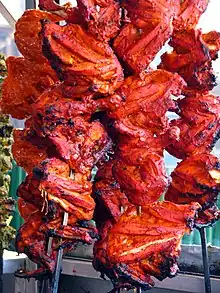
As pork is taboo in Islam, and cattle are inviolable in Hinduism, goat, lamb and chicken are the most popular kinds of meat in South Asia. Note that whenever you see a dish containing "mutton" in South Asia, it primarily refers to goat meat, not older sheep meat like in native English-speaking countries. In Indian and South Asian restaurants abroad, it will more likely be referred to as goat meat to avoid any misunderstanding.
Since many religious movements promote animal ethics, many dishes are vegetarian or vegan. A notable exception to the usual avoidance of pork in Indian food is in Goa, where vindaloo was introduced by the long-time occupier, Portugal, as a dish of pork and garlic in wine or vinegar and was subsequently fused with local tastes to become the spicy dish that is known around the world today.
Seafood and fish are common in coastal and some riparian regions. The ilish, also known as hilsa, is a fish closely related to the herring and is a staple of Bengali cuisine, where it is said to be cooked in over 50 different ways.
Beverages
.JPG.webp)
- In South India, the iconic and most common drink is filter coffee, a sweet and milky coffee with earthier flavours than the typical Western coffee due to a different extraction process and the addition of chicory.
- The warm climate makes fruit juices, sugarcane juice and coconut water popular.
- Rooh Afza is a branded herbal squash concentrate that contains the essences of various fruits, herbs and flowers like rose petals and kewra (screw pine). Formulated in 1906, it is very popular in India, Pakistan and Bangladesh. It is drunk either mixed with water and ice, where it becomes a sherbet, or with milk and ice which looks like strawberry milk but has a more fragrant flavour profile. It can also be used as a syrup which is poured on ice cream and other desserts. The ingredients in Rooh Afza are believed in Unani medicine (the traditional South Asian Islamic medicinal system) to have cooling properties, which is why it is drunk in higher frequencies during the peak summer months.
- Kanji is a fermented, probiotic drink made from black carrots, whose hue is in actual fact a deep purple. Popular in Northern India, it is usually made during the festival of Holi and in the summer months. Kanji has a sharp, acquired taste but is worth a try if you want to experience something new.
- Shikanjvi is a salted and mildly spiced lemonade/limeade from Punjab which in addition to lemon, sugar and salt, can be flavoured with black pepper, cumin, ginger and mint leaves. It is a staple in the peak of oppressive summers, when it helps stave off dehydration and electrolyte loss.
- Solkadhi is a refreshingly tart and creamy drink from Goa and the Konkan region made with coconut milk and kokum, a sour fruit from the mangosteen family which gives the drink its purply-pink colour. It is usually garnished with temperated spices and herbs, such as coriander and mint leaves.
Dairy-based beverages
- A yogurt drink called lassi, in salty, sweet or fruity flavours, is widely available in Northern India and Pakistan.
- Haldi doodh is warm milk infused with turmeric and other spices and is usually sweetened.
- Badam doodh, though literally meaning "almond milk", is not at all what is referred to as almond milk in the West. Rather, it consists of almonds blended with cow's or buffalo milk, which is then sweetened and flavoured with saffron and cardamom.
- Chaas is a buttermilk-like drink referring to the liquid that is left over after churning butter from yogurt. It is usually consumed with a bit of salt added but can also be drunk plain, with spices or sweetened with sugar and no salt added.
Tea
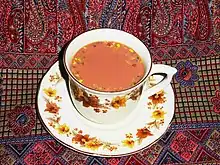
Tea is drunk throughout South Asia and is the everyday drink in many regions.
In India, Pakistan, Bangladesh, Sri Lanka and parts of Nepal, the most common tea is masala chai, sweetened black tea mixed with a blend of spices and milk. While the exact blend varies wherever you are, the most prominent spices in masala chai are cardamom, cinnamon, ginger and cloves.
The traditional drink of Kashmir is noon chai, a pink tea made from green tea leaves, milk, salt and baking soda, which gives it its characteristic colour.
In Bhutan, the Himalayan region of Nepal and the Indian states of Sikkim, Arunachal Pradesh, Himachal Pradesh and the union territory of Ladakh where there is Tibetan cultural influence, butter tea is the drink of choice. Pu-erh tea leaves, yak or cow's butter and salt are blended together to create butter tea, which has a stew-like consistency.
Alcoholic beverages
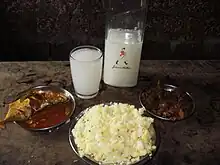
Customs for alcoholic beverages vary a lot between countries and regions. Alcohol consumption is prohibited in the Muslim-majority countries of Pakistan and Bangladesh, although in theory the ban is for Muslims only. Among similar lines, the only place where it is legal to drink alcohol in the Maldives is at resorts.
The Indian states of Bihar, Gujarat (although liquor permits are available), and Nagaland, Mizoram, 4 districts in Manipur and 2 districts in Maharashtra and the union territory of Lakshadweep (with the exception of Bangaram) do not permit the consumption of alcohol. The parts of India which do allow the sale and consumption may have laws and regulations not typically seen in Western countries such as dry days where the open sale of alcohol is prohibited on certain public holidays and during elections (resorts and 5-star hotels usually exempted). Most Indian states have a legal drinking age of 21, though it is 18 in Rajasthan, Andhra Pradesh and Sikkim and 25 in Punjab and Haryana.
Sri Lanka doesn't allow women to buy alcohol. However, everyone aged 21 and above is legally allowed to consume alcohol. The sale of alcohol (but not private consumption) is prohibited on every full moon day, which are referred to as Poya Days in Sri Lanka.
Nepal's legal drinking age is also 21 (pregnant women are not allowed to buy alcohol) while it is 18 in Bhutan, where alcohol is quite freely available.
There are several alcoholic drinks unique to the subcontinent, including:
- Toddy is a moderately alcoholic drink made from the fermented sap of the coconut palm tree. Also known as palm wine, it has an ABV of about 8.1%. It is cloudy white in colour and has a touch of sweetness in its taste. Toddy is commonly drunk among the rural folk in South India, parts of Western India and Sri Lanka. You may offered home brewed or moonshine versions of toddy when you visit the beaches on the southwestern coast of India.
- Feni is a double or triple-distilled spirit from Goa, most often made from the juice of ripe cashew apples. With an alcoholic content of 40-45%, it is potent with subtle fruity notes. Feni can be served neat in a shot glass, with ice or as part of a lemony cocktail.
- Arrack is in its most common form a coconut spirit, essentially double-distilled toddy, and is popular in Sri Lanka and parts of India. It is aged in barrels made from the wood of the Halmilla (Berrya cordifolia) tree. Its taste is said to be a blend of whisky, rum and tequila. It is either drunk by itself or with ginger beer.
Globally available alcoholic beverages are also very common, particularly in urban areas.
- Beer is growing in popularity in India. The most widely consumed beers are pale lagers. There has been a surge in interest in craft beers, and several microbreweries have opened up across the country.
Dishes
South Asia has a plethora of dishes, many of which have become well known and eaten across the region and abroad, while others continue to be local delicacies. This section will focus on savoury dishes. For sweet dishes, see the "Sweets and desserts" section below.
Curries
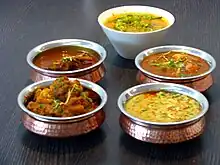
A curry is a dish based on herbs and spices, together with either meat or vegetables. A curry can be either "dry" or "wet" depending on the amount of liquid. In inland regions of Northern India and Pakistan, yogurt is commonly used in curries; in Southern India and some other coastal regions of the subcontinent, coconut milk is commonly used.
Famous meat-based curries include:
- Butter chicken – a relatively modern invention created in the 1950s by the Moti Mahal restaurant in Delhi, this dish consisting of chicken cooked in a mildly spiced tomato and butter sauce is arguably the most well known Indian curry worldwide. Pairs well with naan and/or basmati rice.
- Rogan josh – a fragrant Kashmiri curry where braised lamb/mutton or goat meat is flavoured and coloured with the alkanet flower, Kashmiri chillies, and spices which emphasise aroma rather than heat, such as cloves, cinnamon and cardamom.
- Vindaloo – a fiery curry from Goa where meat (traditionally pork) is marinated and cooked in vinegar, chilli peppers and a stack of other spices. Sometimes cubed potatoes are added.
- Laal Maas – literally meaning "Red Meat", the meat is cooked using yogurt, garlic and liberal amounts of Mathania chilli, from which it derives its name and deep red hue. Originally, the meat was wild game such as boar or deer and the dish was made for the royalty in the Mewar Kingdom in Southern Rajasthan. Nowadays, goat or lamb is used.
- Nihari – a flour-thickened stew of beef, goat or lamb shanks and bone marrow, immersed with spices and slow cooked for six to eight hours. Originating from the royal Mughal kitchens of Delhi and Lucknow, it has become strongly associated with the cuisine of Pakistan, though it is also available across Northern India.
- Jalfrezi – a fusion Indian-Chinese dish originating from Bengal where the meat (most commonly chicken), green chillis, capsicum (bell peppers) and onions are stir-fried and incorporated into the curry.
There is a rich array of seafood curries found throughout the coastal regions of South Asia.
- Chingri malai – a creamy Bengali dish made with prawns cooked in a coconut milk-based sauce flavoured with turmeric, mustard, chillies and other spices. It is served with rice and is especially popular at Bengali weddings.
Legumes play an important role in satisfying the protein requirements of the vegetarian and semi-vegetarian communities in South Asia. Some of the most well known legume-based curries are:
- Rajma – red kidney beans mixed with tomatoes, onions and a myriad of spices. A specialty of Punjab, rajma is commonly paired with basmati rice though it is still delicious when eaten with any kind of flatbread.
- Channa masala – a chickpea (garbanzo bean) curry with a balance of spicy and tang, the latter of which comes dried pomegranate powder or dried mango powder. Can be made with white chickpeas, the kind that is found worldwide, or with black chickpeas, a smaller, darker and firmer type of chickpea unique to the subcontinent and which has a nuttier flavour. In the street food stalls of Northern India and Pakistan, channa masala is usually served with bhatoora or kulcha flatbreads.
- Lobia – a black-eyed pea dish which uses liberal amounts of ginger, onions and lemon juice.
- Hara Dhaniya Cholia – a dish from Haryana centred around green chickpeas and coriander leaves (cilantro). It is traditionally eaten during the winter months.
Curries with dairy products as the primary ingredient are prevalent in Northern India and Pakistan.
- Palak paneer – cubed chunks of paneer coated in a puréed spinach sauce
- Kadhi – a curry made with sour yoghurt and gram flour and tempered with spices. The Northern Indian version is thicker, golden in colour and usually contains pakoras (fritters) while the Gujarati version is thinner and whiter in appearance.
Rice dishes
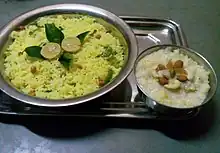
- Biryani – a savoury dish of meat (traditionally goat, though chicken, lamb and beef are used as alternatives), rice and spices that is popular throughout most of the Subcontinent and beyond. Brought by the Mughals, it is associated with the Muslim community and exists in many different styles throughout South Asia and among overseas Indian communities, but the most famous style is the version served in Hyderabad. It is similar to several Middle Eastern rice dishes such as kabsa, mandi and mansaf. A related but distinct dish is pulao. The key differences between the two are that firstly, the rice in biryani is parboiled and then drained of its water while in pulao the rice absorbs the water or stock and secondly, the components of biryani (meat, rice and vegetables) and cooked separately and later brought together in layers whereas in they are sauteed together in pulao with no layering involved.
- Lemon rice or Chitranna – a South Indian dish, especially popular in Karnataka, made by seasoning rice with split chickpeas, black gram, peanuts, mustard seeds, turmeric and generous amounts of lemon juice, which gives it its characteristic tang. Other ingredients like cashews, green beans, chillies and onions are optional. It is eaten at any time of the day though breakfast is most common. It can be eaten by itself or be accompanied by a chutney or raita (yoghurt condiment).
- Bhuga chawal – a Sindhi speciality where roasted and browned rice is immersed in spices and browned onions. Often eaten with Sai Bhaji (a curry comprised of lentils, spinach, and other greens like dill, fenugreek and sorrel).
Savoury cakes and crepes
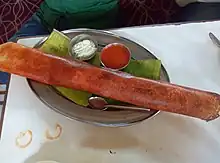
- Appam (also called Appa or Anglicised to hoppers) – a bowl-shaped crepe made from fermented rice batter and coconut milk. It is a popular breakfast dish in South India, especially Kerala, as well as Sri Lanka. A common variation is muttai appam where an egg is cracked into the centre of the appam as it cooks.
- Dosa (called thosai in Tamil) – a savoury rice and lentil crepe that is a staple of South Indian cuisine, such as in Tamil Nadu and Karnataka. They are often stuffed, such as with a mixture of potatoes, onions and spices (this type of dosa is called masala dosa), but many types of stuffing are possible. The "rava" (semolina) masala dosas from Mysore are particularly famous.
- Dhokla – a steamed, leavened savoury snack originating from Gujarat, having a cake-like texture and made from rice, chickpea and/or lentil batter. The most popular type is khaman dhokla made from chickpea flour, garnished with mustard seeds, curry leaves and green chillis, and typically served with a red or green chutney. It is eaten as a breakfast item, entree to a meal or as a snack with tea.
- Handvo – sometimes said to be a complex cousin of the dhokla, handvo is a savoury Gujarati cake made with a rice, lentil and yogurt batter and with a bottle gourd filling, though other vegetables can also used in the filling.
- Idli – a steamed savoury cake shaped as a patty which originates from South India and is made from fermented black gram and rice batter. Popular as a breakfast item and bland on its own, idlis are served with coconut chutney, sambar (lentil and vegetable stew) or rasam (tamarind soup). Variations include idlis made from rava (semolina) or ragi (finger millet).
- Utthapam – a savoury pancake. Like masala dosas, they are a staple of South Indian cuisine and exist in many varieties. Unlike masala dosas, they are not rolled around stuffing but include the ingredients in the batter.
Kebabs
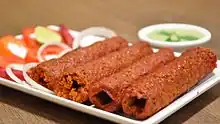
In the South Asian context, kebabs refer to a range of char-grilled meat dishes, which are often but are not necessarily cooked on skewers. Kebabs were introduced to the region during the reign of the Delhi Sultanate and evolved and became more gastronomically refined during the Mughal era. In India, vegetarian versions of kebabs have also been created. They are ubiquitous in the street food scene and are also served as starters in restaurants.
- Seekh kebab – ground or minced meat is blended with spices, moulded on skewers into a sausage-like shape and cooked over a flame grill. Seekh kebabs are the most common kebab dish you would find within a restaurant.
- Reshmi kebab – boneless chicken pieces are coated in a silky marinade of yogurt, cream and cashew nut paste and then grilled. They are crusty on the outside and soft and succulent inside.
- Chapli kebab – originates from Peshawar and is a specialty of Pashto-speaking areas, namely the Khyber Pakhtunkhwa province in Pakistan and Eastern Afghanistan but found elsewhere too. Minced meat, most commonly beef, is mixed with flour and a spice blend, and then pounded into a flat patty. The kebab looks like someone stepped on it with their slippers or flip-flops (called chappals in many South Asian languages) from which it derives its name. Typically consumed with naan, pulao rice or in a wrap or bun, where it becomes a small burger.
- Shami kebab – patties made by mixing minced meat with channa dal (yellow split pea), eggs and spices. It is one of the few kebabs which is pan or shallow fried because the patties are too delicate to be grilled.
- Hariyali kebab – chicken kebab pieces coated in an aromatic green paste, deriving its vibrant colour from spinach, mint and coriander leaves.
Salads
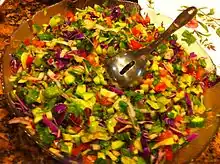
Salads are rarely, if ever, the main meal. However, they can be a side dish accompanying the rest of the meal. The light, zesty and refreshing feeling from salads provides balance when eaten with a rich curry.
- Kachumber – this classic, everyday salad from Northern India contains the essential trio of chopped up cucumber, onions and tomatoes seasoned with salt, black pepper, cumin powder, red chilli powder. Green chillis and herbs like coriander and mint may be added. The dressing is either lemon or lime juice with no sugar or oil added. A similar salad from Afghanistan called Salata or Afghan salad usually has the same triad of vegetables with the addition of carrots and may contain other herbs such as parsley and dill.
- Mooli lachha – a salad from Uttar Pradesh with grated radish as its base, seasoned with lemon, salt and chaat masala (a tart spice mix) and garnished with green chilli, coriander, ginger and sometimes carrots.
- Kosambari – a South Indian salad consisting of split mung beans, grated coconut and carrots, tempered with mustard seeds and curry leaves.
- Singju – a spicy Meitei Manipuri salad with countless variations. Popular versions include yangchok (stinky bean), pea leaves, cabbage, ngari (fermented punti fish), lotus root, chilli and perilla seeds.
- Wahan Mosdeng – a Tripura-style zesty salad prepared with shredded or thinly sliced pork, roasted green chillis, onions, ginger and coriander leaves.
Egg dishes
- Egg bhurji – scrambled eggs with sautéed tomatoes and onions which are garnished with herbs like coriander. A popular street food and breakfast item, it is often served with toasted bread slices.
- Nargisi kofta – boiled eggs which are encased in seasoned mince meat and flour, deep fried and then braised in a rich yogurt-based gravy. It is essentially Indian-style scotch eggs. The dish is named after the narcissus flower, which is what one of the koftas looks like on the inside when it is cut in half.
- Ros omelette
Soups
- Thukpa – a warming noodle soup eaten in the Himalayan regions containing meat (usually chicken, mutton or yak) and an assortment of vegetables. Vegetarian versions of thukpa have also become popular in Nepal and India.
- Mulligatawny – a creamy and peppery Anglo-Indian soup with origins from Tamil Nadu which typically consists of chicken, vegetables, coconut milk and apples for a touch of sweetness.
Other dishes
Snacks
There are a wide array of traditional and modern snacks across the subcontinent. The line between "snack" and "meal" can be blurry. Many of the snacks described below are indisputably snacks while others if eaten in sufficient quantity or combined with other foods are often eaten as a small meal, especially for breakfast or lunch. On the flip side, some dishes described in the section above can become snack food when eaten in smaller portions.
Chaat refers to a group of snacks that feature an element of fried dough which is combined with other ingredients to create spicy, tangy, savoury and sometimes sweet flavours. They are served as street food by roadside vendors and as starters or appetisers in restaurants, occupying a similar space to tapas in Spanish cuisine.
Another category of snacks is namkeen, which refer to salty snack mixes akin to convenience foods like potato chips, popcorn and cheese puffs. Namkeen is typically eaten with tea, coffee or alcoholic drinks.
Fried snacks

- Samosa – a savoury, tetrahedral or triangular pastry filled with potatoes, peas and onions. Minced meat samosas are also popular, especially outside India. Coming in a variety of sizes, samosas are generally served in a chaat form form immersed in chickpea curry, or with tamarind and mint chutney.
- Pakora – also spelt as Pakoda or referred to as Bhaji in some regions, pakoras are fritters that are coated in a spicy gram flour (ground chickpea) batter. The types of pakoda range from sliced and chopped vegetables like potato, cauliflower, eggplant and onion, to paneer and even bread slices. Other flours which may be used in the batter include buckwheat and water chestnut. Pakoras pair well with almost every chutney and sauce.
- Murukku – a hard and crunchy coil-shaped snack originating from South India. Standard murukku is made with rice flour, black gram flour and seasoning which includes chilli powder, asafoetida, carom seeds and sesame seeds. A related snack is chakli, which is popular in Maharashtra and sees the addition of gram (chickpea) flour into the batter mix.
- Kachori – a round, flaky pastry stuffed with a split mung bean filling which is popular in the Hindi belt, from Jodhpur to Varanasi. A special version from Rajasthan called pyaz ki kachori uses onions as the stuffing instead of mung beans.
- Aloo tikki – a crispy patty made from mashed potatoes and peas, which bears some similarities with a hash brown and bubble and squeak, and is served with toppings such as chutney, yogurt, onions and pomegranate.
- Chicken 65 – deep-fried chicken pieces which derives much of its flavour from red chilli, curry leaves and garlic. Invented by the Buhari Hotel in Chennai, Chicken 65 is accompanied by slits of green chilli, onion slices and a lemon wedge.
- Amritsari fish – bite-sized pieces of white fish (traditionally singara/sole which is a catfish, or rohu, a riparian fish in the carp family) are lightly coated in rice flour, gram flour and spices and is then double fried to become a crispy appetiser. A traditional dish of Amritsar, the aroma of ajwain (carrom seeds) provides a distinctive flavour to the fish. Across the Indian-Pakistan border in Lahore, a very similar dish called Lahori fish lacks the flour coating and is more subtly spiced.
Sandwiches and wraps
- Vada pav – commonly referred to as India's version of the burger, the quintessential fast food from Mumbai consisting of an oval-shaped mashed potato fritter and a deep-fried whole green chilli sandwiched between two pav bread buns, which is laced with green chutney and dry garlic chutney.
- Dabeli
- Kati roll – a wrap originating from Kolkata made with a flaky and white flour version of paratha bread, which is filled with meat, egg or paneer along with onions, chutney and a squeeze of lime juice. The name derives from the Bengali word for bamboo stick of skewer, on which the kebaba meat was traditionally cooked.
- Frankie
Biscuits and crackers
- Nankhatai – a traditional Indian shortbread biscuit or cookie made with flour, ghee and sugar and flavoured with cardamom. Believed to have originated from Surat in the 16th century, nankhatai are nowadays popular all over Northern India, Pakistan, Bangladesh and Myanmar. The texture of nankhatai is crisp on the outside but crumbly and melt-in-your-mouth on the inside.
- Osmania biscuits – tea biscuits with a simple round shape that combines sweet, salty and buttery flavours. They were baked for and named after Hyderabad's last princely state ruler Mir Osman Ali Khan, and have since become the most popular item in virtually every bakery in Hyderabad.
- Papadum – a large and thin, disc-shaped cracker which is made with black gram. It can be fried or dry roasted. Papadums are the quintessential starter in restaurants serving Northern Indian and Pakistani cuisine.
- Khakra – a thin cracker from Gujarat with wheat flour and moth beans as its main ingredients. It is usually flavoured with fenugreek leaves and is eaten during breakfast.
- Thekua – A cookie from Bihar, Jharkhand and the Terai region of Nepal, which has crispy and crumbly outer layer and soft centre. It is made from whole wheat flour, coconut, ghee, green cardamom and sugar.
Condiments
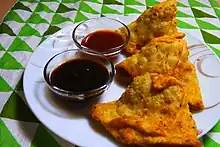
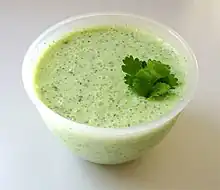
Broadly, the two major types of condiments found in South Asian cuisine are chutneys, which are equivalent to sauces, dips and spreads in European cuisines, and pickles, called achar in many languages of the subcontinent.
Chutneys
Chutneys can be savoury, sweet, sour or spicy and served as an accompaniment to snacks such as samosas, pakoras and dhokla, and some types of meals, including dosas and utthapams.
- Coconut chutney – a thick, creamy and nutty chutney which centres on coconut, roasted lentils, ginger and chilli. With a hint of sweetness and spice, it is an essential accompaniment to South Indian dishes, such as the dosa, idli and vada.
- Green chutney – derives its colour and freshness from the combination of coriander, mint and green chilli. Salt, spices and lime juice are also added to give the condiment an extra kick. Green chutney is ubiquitous in Northern and Western India.
- Tamarind chutney – a reddish-brown sweet and sour chutney which may resemble barbecue sauce. It primarily consists of tamarind, ginger and pink salt and is sweetened with jaggery, sugar, dates or a combination thereof. Sesame or fennel seeds are sometimes added. It is used a dressing over chaat dishes and as a dipping sauce with samosas, kachoris and other Northern Indian snacks.
Pickles
South Asian pickles tend to be spicy and salty and are often oil-based. They accompany meals and pair with foods which are somewhat bland. Pickles are very strong in flavour and salt and are meant to be eaten in very small portions per bite with the bread, rice and/or curry. They are supposed to provide a kick to the meal but eating them in large quantities will overwhelm your taste buds.
When oil is used in the pickling process, the type of oil used varies by region. Northern India, Pakistan and Bangladesh favour mustard oil, which is aromatic and pungent, while sesame oil, which has a delicately nutty flavour, is preferred in Southern India.
- Mango pickle – popular in nearly every part of South Asia with countless varieties existing throughout the region. Unripe, green, baby mangoes are used for pickling, which are sour, less sweet and have a firmer texture.
Other condiments
Another condiment, or perhaps more accurately side dish, eaten throughout Northern India, Pakistan and Bangladesh is raita. Raita comes in many varieties, each one made from yogurt mixed principally with an herb, vegetable, pulse or fruit. A bit of salt and pepper can be added as well as water to thin the blend. From a gastronomical perspective, raita cools you down from the heat of the curry and the rest of the meal. Raitas are diverse with many states having their own style though the most common ones are boondi raita (containing small, cereal-like fried batter balls of besan or chickpea flour), cucumber (similar to tzatziki in Greek cuisine) and mint (popular during the summer).
Lunu miris is a Sri Lankan sambal, or chilli paste, a blend of red onions, red chilli peppers, chilli powder, lime juice and Maldive fish. It is commonly served with roti, kiribath (rice and coconut milk mounds) or hoppers.
Sweets and desserts
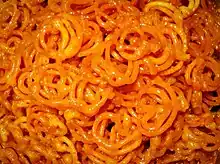
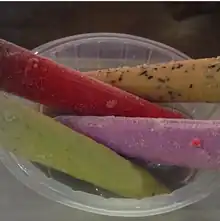
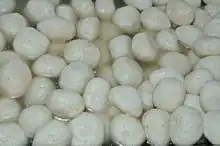
It's fair to say that nearly everyone has a sweet tooth in South Asia. Sweets can be baked, fried, roasted, frozen, or produced in a myriad of other ways. Increasingly, sweets which were specific to one region are spreading in popularity and are available across the entire region. Sweets are given as gifts to family and friends and consumed at higher rates during festivals, whether religious or secular. They are eaten typically after a main course meal or as in-between snacks.
Gulab jamun is a dairy-based dessert consisting of fried and caramelised milky balls dipped in a rose- and cardamom-scented syrup and garnished with an assortment of nuts. Generally gulab jamun is served hot. The traditional recipe uses khoya (freshly dried milk) which provides a melt-in-your-mouth feel to the dish. These days you might come across gulab jamun made from milk powder, which is easier to make but not as tasty. Gulab jamun spread in popularity during the Mughal Empire and is therefore available across much of South Asia and among the diaspora communities all over the world. A variant of the dish is the kala jamun, which is darker in colour, has a drier and crispier texture and is served at room temperature.
Halwa refers to a variety of dense confections whose texture can vary from moist and creamy like a pudding to dry and hard like candy. It usually consists of base ingredients cooked in ghee and sugar, sometimes milk is added for consistency and is garnished with nuts, raisins and shredded coconut. The most common halwa is made from sooji (semolina). Other popular varieties include gajar (carrot) and atta (whole wheat).
Jalebi is made by deep frying white flour batter in coil or pretzel-like shapes and soaking it in syrup, usually flavoured with saffron. It's eaten as a snack, a dessert, or a breakfast item. Jalebi is often served with milk or rabri (a kind of fragrant condensed milk). With its origins in the Middle East, jalebi enjoys pan-South Asian popularity though the name of the treat varies by region. The central Indian state of Madhya Pradesh has put a unique twist on the standard recipe and is known for its mawa jalebi which uses milk solids in place of flour and is dark brown and soft instead of the usual orange and crispy.
Kulfi is a frozen dairy dessert eaten across all South Asian countries with its popularity stretching as far as Myanmar. Often dubbed "Indian ice cream", its taste for the most part will remind you of ice cream though there are a few key differences. Kulfi is made from evaporated milk and sugar does not contain eggs and is not whipped or aerated. As a result, kulfi is denser, creamier and slower to melt than ice cream and can have a slightly chewy texture. The most common shape of kulfi is a long, thin cone. When you buy it from stalls or trucks on the street it is usually served on a stick, while in restaurants it is given in a cup or plate. The traditional flavours include malai (cream), cardamom, rose, pistachio, mango and saffron. For those with allergies, keep in mind that even non-nut flavours often contain nuts (almonds, pistachios and cashews being most common). Nowadays, much like ice cream, you will find hundreds of flavours as you shop around and go to different vendors.
Laddus are sweets shaped as round balls that are made from a flour or base ingredient, ghee and sugar. They may contain nuts and other flavourings. The laddu is the among the most ancient of sweets in the subcontinent with archaeological excavations finding the precursor to laddus being consumed in the Indus Valley Civilisation over 4,500 years ago. The most popular varieties of laddu are besan (chickpea), motichoor (made from combining small fried balls or "pearls"), coconut and sesame.
Rasgulla, also known as rosogolla, is an Eastern Indian sweet consisting of balls of chhena (a moist, softer cheese than paneer) cooked and permeated in a light rose-scented syrup. The origin of rasgulla is disputed between Odisha and Bengal with people on either side of the border claiming that it was invented in their state. What is more clearly known is that the first canned rasgullas were sold in Calcutta (present-day Kolkata) in 1930, after which they took off in popularity across the subcontinent. A variant of the dish is ras malai where the chhena balls are immersed in sweet thickened milk instead of syrup, providing a creamier feel to the sweet.
Shrikhand is a Maharashtrian dessert made from strained and sweetened yoghurt. It has a silky and creamy texture, is flavoured with saffron and cardamom and is garnished with nuts and rose petals.
Rice puddings
- Kheer, also called payasam or payesh, is the most well known type of South Asian rice pudding. The default version contains rice, sugar and thickened milk as a minimum and is usually flavoured and garnished with cardamom, saffron, raisins, nuts, petals and/or floral essences. It can be eaten cold at the end of a meal or hot at the start or end of a meal like porridge. Variants of the dish substitute the rice with other grains or pseudo-grains such as bulgur, sago, vermicelli and tapioca.
- Phirni is a pudding made with ground rice or rice flour, milk and sugar and flavourings. It served in earthen clay pots called shikoras or matkas, which absorb excess moisture and liquid. These subtle differences make phirni have a thicker, smoother and creamier texture than kheer. Phirni is also always served chilled unlike kheer.
- Doodh Pak is a rice pudding originating from Gujarat. It has a much lower rice-to-milk ratio than kheer. As a result, doodh pak has a runnier consistency and is almost drinkable. Doodh Pak is usually accompanied with puris (fried whole wheat flatbread).
Restaurants
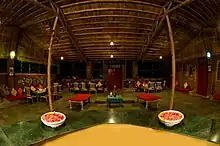
When travelling across South Asia, you will come across restaurant types that are found all over the world from fast food to fine dining and everything in between. In addition, there are types of restaurants which are unique to the subcontinent.
- Dhaba: The dhaba is a roadside restaurant usually on highways that caters to truck drivers and others stopping over between towns. Far from being fancy, dhabas have a rustic ambience. Originally built as mud shacks, they typically have no air-conditioning or heating. The food you get is of a simple, homemade style specific to the area and served on big brass or steel plates called thalis. The original purpose of dhabas was to provide truck drivers with an affordable, freshly cooked meal. Nowadays, you will find eateries in the middle of the city and suburbs offering "dhaba-style" food.
- Irani cafe: These cafes were opened by Zoroastrian Irani immigrants who came to the subcontinent in the 19th century. There are many Irani cafes in Mumbai and Hyderabad in India, and a few in Karachi, Pakistan though over time their numbers have been diminishing. The internal decor of Irani cafes tends to have a classic colonial touch. The word "cafe" is bit of a misnomer as they don't serve coffee but rather are noted for their Irani chai (a strong, sweet and very creamy tea) and bakery and breakfast items including khari biscuits, bun maska (soft bread and butter), brun maska (hard buttered croissants), keema pav (minced meat buns) and akuri (spicy scrambled eggs).
Thalis
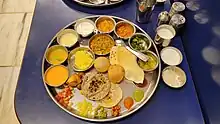
In many restaurants across South Asia as well as South Asian restaurants abroad you will come across a type of meal called a thali or bhojanam. Literally meaning large plate, thali also refers to the meal served on the large round plate or platter. Thalis consist of multiple dishes presented either in small bowls or built-in compartments within the plate.
A thali includes a serving of rice, flatbread or both, dal, vegetables and an assortment of curries. This is usually accompanied by papadums, raita or yogurt, chutneys and pickles. Thalis may also include desserts which are served in different bowls or compartments. In restaurants, you can order thalis based on region (e.g. Punjabi or Bengali thali) or by type of food served (vegetarian, seafood, etc.).
Thalis are the ideal way to sample a bit of everything. They are designed to provide a complete and balanced meal in terms of nutrition, textures and flavours. All six tastes in Ayurvedic tradition (sweet, sour, salty, bitter, pungent, astringent) are experienced in a single sitting.
Plating
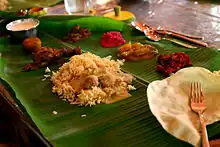
In Sri Lanka, South India, and some other parts of India, meals are traditionally served on banana leaves or the leaves of other plants such as kenda (Macaranga peltata), lotus and the areca palm. Banana leaves are larger than standard plates, allowing for more dishes and condiments to be served in one go. The leaves are biodegradable and disposable, making them eco-friendly compared to plastic plates. The waxy surface of the banana leaves melts when hot food is served on it, which imparts a subtle sweetness to the food and is believed to provide health benefits.
According to South Indian eating etiquette, you should fold the leaf inwards, i.e. towards yourself, once you finish your meal. Folding it outwards is only done during funerals and is otherwise considered rude.
See also
- Cambodian cuisine
- Chinese cuisine
- Malaysian cuisine
- Middle Eastern cuisine
- Travelling during Ramadan
- Western food in Asia